Lupine (Lupinus) Profile
Written by Iris
Aug 27 2021
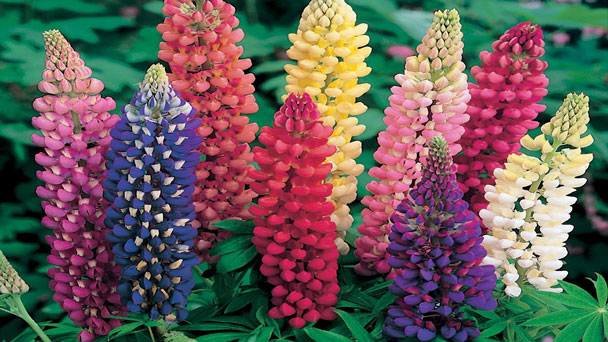
Lupine (Lupinus) are as simple as planting seeds or seedlings in a sunny area with well-drained soil. Lupine (Lupinus) like to grow in rich, slightly acidic soil in plenty of sun. When in place, they require little care other than removing used flowers to encourage additional flowering.
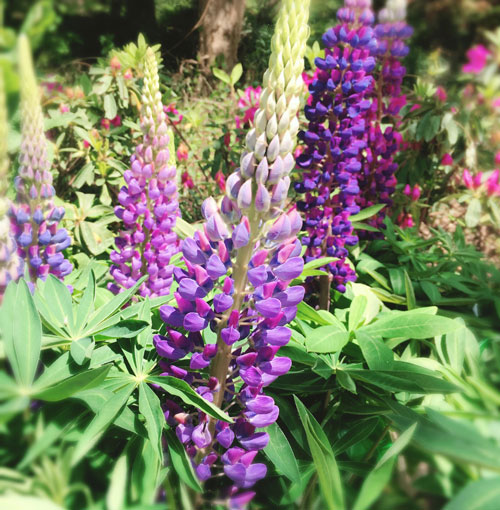
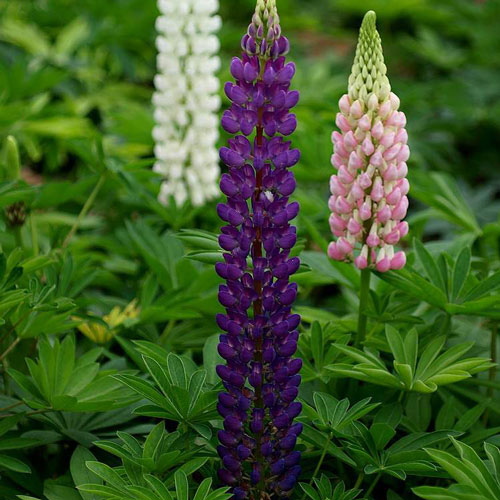
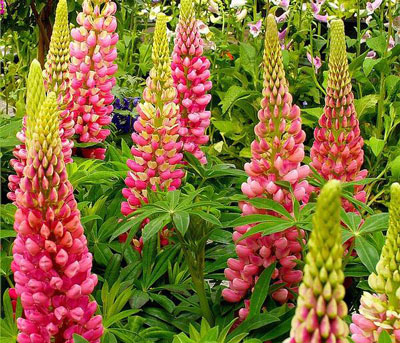
Soak the lupin seeds for 24 hours in cold water or nick the outer seed coat with a knife to promote even germination.
Plant out when quite small, as lupin seeds develop a taproot and resent disturbance to their roots.
Moisten the sand and allow the containers to drain so that there is no standing water. The sand should be construction or masonry sand, not play sand. Playing is very fine and holds water.
Cut the stem of a mature lupine with a sharp knife or razor blade. The nail should have a “heel” or a small section of the original nail attached to the basal end of the cut. A well-harvested cut will look as if a flap of the parent plant’s bark is still attached to the end of the cut stem.
Remove all leaves from the stems of the lupine, except the upper part, holding the upper part of the stem with one hand and sliding the rest of the stem between your index finger and thumb. Make a horizontal cut in half of the remaining leaves so that the leaves are half the original size. Glue the cuttings to the coarse sand and firm the sand around the stem.
Insert wooden skewers or bamboo poles into the sand along the outer edge of each cultivation container. Keep the tips of the piles about 2 to 3 inches above the lupine piles.
Cover the cultivation container with a clear plastic film so that the cuttings are covered, but the plastic rests on the cuttings. Hold the plastic in place with an elastic band around the top edge of the container.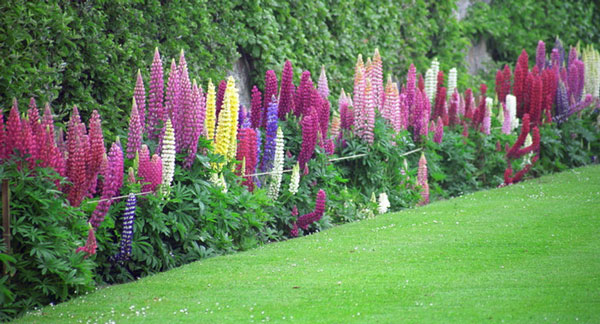
Temperature and Humidity
Lupines like climates with fairly cool summers. They don't do well in hot, humid climates, such as that of the Southern United States.
More details on how to grow and care for Lupine.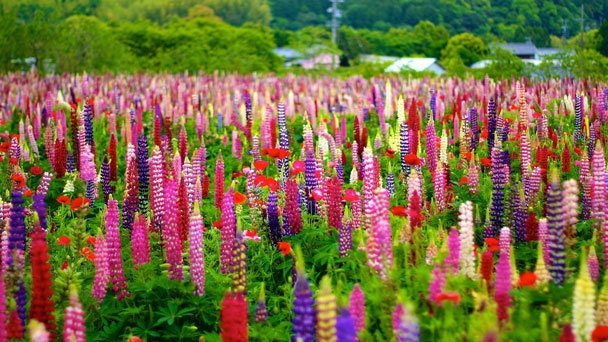
In the feed and food industry, the seeds of specially grown, low-alkaloid varieties of the sweet lupines are used and processed into yoghurt, spreads, ice cream, milk, flour or even used as sausage and meat substitutes.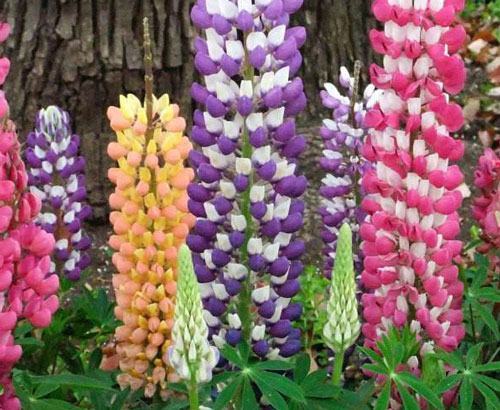
Arroyo Lupine: A natural species that grows mainly in California. It has purplish flowers that bloom in the spring. However, it’s highly toxic so you have to handle it with care and keep it away from pets and children.
Arctic Lupine: A cultivar that is more accustomed to Alaskan weather conditions. The flowers are either blue or purple. It grows well even in poor soil and enriches it with nitrogen with its taproots.
Riverbank Lupine: A popular variety that dazzles with its natural beauty and bright flowers. It also has many benefits and practical uses. It restores nitrogen in depleted soil, prevents soil erosion, and has a strong fragrance. If you want to choose only one lupine, this is the one.
Blue Pod Lupine: A tall and elegant cultivar that gardeners love to grow outdoors. Many lupine hybrids come from this cultivar although they usually have better flowers and deeper colors.
Texas Bluebonnet: Bluebonnet is another name for lupines. However, this particular species has special protection in Texas. It's the state flower and you’re not allowed to pick the flowers in the wild or harm them in any way. You can grow them in your garden of course. They have blue-purple colors and are easy to grow.
Russell Lupine Mix: This species grows to about 3 feet tall and the flowers bloom in various colors. The interesting thing about this variety is that when you buy the seeds, you can't tell what the plants will be like. So if you plant them in a group, you might end up with different lupines that all belong to this species.
Poor flowering may be caused by too much shade or by dividing clumps too often. With plants in containers, it may also be caused by overpotting or being excessively pot-bound. Repot every three years or so, into a container that is only slightly larger. To improve flowering, water and feed in spring
Several pests have a taste for lupins, principally slugs and snails, which love the new shoots in spring, but also look out for lupin aphids
Fungal diseases such as lupin anthracnose and powdery mildew can affect lupins, along with viruses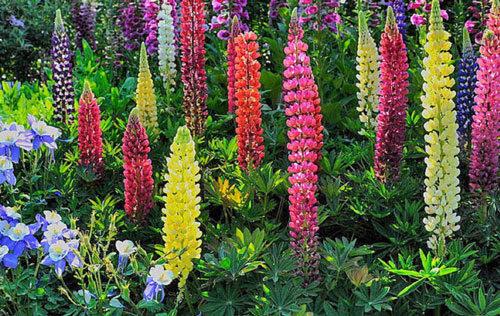
This flower is available in several colors that are complementary to lupines, including yellow, white, pink and red. Iris grows 20 to 27 centimeters in height and grows in various types of soil, from sand to clay. Like lupines, they are drought-tolerant and grow in full sun or partial shade.
Like lupines, Shasta daisies bloom in summer and fall. In addition, Shasta daisies attract butterflies and bring colorful life to the garden.
Hawks grow in most types of soil and are moderately drought tolerant. They bloom from mid spring to late summer.
Lupine (Lupinus) PictureLupine (Lupinus) InfoEcological Habits of Lupine (Lupinus)Lupine (Lupinus) Distribution AreaHow to Grow and Care for Lupine (Lupinus)Uses of Lupine (Lupinus)Varieties of Lupine (Lupinus)Lupine (Lupinus) Common Pests/DiseasesLupine (Lupinus) Companion Plants
Lupine (Lupinus) Picture

Lupine (Lupinus) Info
| Common Names | Lupine, bluebonnet |
| Botanical Name | Lupinus x hybrida |
| Family | Fabaceae |
| Plant Type | Herbaceous, perennial, annual |
| Mature Size | 3–4 ft. tall, 1–1.5 ft. wide |
| Sun Exposure | Full |
| Soil Type | Rich, moist, well-drained |
| Soil pH | Acidic, neutral |
Ecological Habits of Lupine (Lupinus)
Lupins form mounding upright clumps of fresh green foliage, dissected into leaflets like the spokes of a wheel. Upright spikes of dramatic flowers in singular or two-tone colour combinations arise from the domes of foliage in spring and early summer. These colours include shades of blue, purple, pink, yellow, red, orange and white. There are dwarf cultivars from 0.6 metres high to tall varieties up to 3 metres. The most famous are the Russell lupins, although many species and cultivars are grown as green manure crops, to provide fodder for animals, or for human food production including flour.
Lupine (Lupinus) Distribution Area
Lupines (Lupinus) are a genus from the family Fabaceae. Nowadays, you will find 200 to 50 different species of the genus. The Lupine originally comes from North America. Both perennial and annual varieties are available. In the garden there are mainly cultivated forms of the shrub-lupine (Lupinus polyphyllus). The lupine impresses with its rapid growth and a conspicuous bloom that lasts from early summer to August. The numerous varieties of this plant not only brings a riot of colors to the cottage garden. The annual lupines can also be sown as green manure. In flower beds, the perennial shrub is a reliable filler because it also sows itself.
How to Grow and Care for Lupine (Lupinus)
How to Grow Lupine (Lupinus)
- With Seeds
Soak the lupin seeds for 24 hours in cold water or nick the outer seed coat with a knife to promote even germination.
Plant out when quite small, as lupin seeds develop a taproot and resent disturbance to their roots.
- With Cuttings
Moisten the sand and allow the containers to drain so that there is no standing water. The sand should be construction or masonry sand, not play sand. Playing is very fine and holds water.
Cut the stem of a mature lupine with a sharp knife or razor blade. The nail should have a “heel” or a small section of the original nail attached to the basal end of the cut. A well-harvested cut will look as if a flap of the parent plant’s bark is still attached to the end of the cut stem.
Remove all leaves from the stems of the lupine, except the upper part, holding the upper part of the stem with one hand and sliding the rest of the stem between your index finger and thumb. Make a horizontal cut in half of the remaining leaves so that the leaves are half the original size. Glue the cuttings to the coarse sand and firm the sand around the stem.
Insert wooden skewers or bamboo poles into the sand along the outer edge of each cultivation container. Keep the tips of the piles about 2 to 3 inches above the lupine piles.
Cover the cultivation container with a clear plastic film so that the cuttings are covered, but the plastic rests on the cuttings. Hold the plastic in place with an elastic band around the top edge of the container.
- With Division

How to Care for Lupine (Lupinus)
- Light
- Soil
- Water
Temperature and Humidity
Lupines like climates with fairly cool summers. They don't do well in hot, humid climates, such as that of the Southern United States.
- Fertilizer
- Pruning
More details on how to grow and care for Lupine.

Uses of Lupine (Lupinus)
Since lupine seeds have a high protein content, the seeds were processed and eaten by our ancestors. The blue lupine was even grown as a coffee substitute in farm gardens. Lupine seeds have been considered as food and medicine since ancient times. But take care while experimenting: The lupines growing in the garden are poisonous as a whole, because lupins contain large amounts of alkaloids.In the feed and food industry, the seeds of specially grown, low-alkaloid varieties of the sweet lupines are used and processed into yoghurt, spreads, ice cream, milk, flour or even used as sausage and meat substitutes.

Varieties of Lupine (Lupinus)
Despite the fact that lupines come in a wide variety of species, experts were not satisfied. They wanted to improve the plant with new hybrids and cultivars that bloom longer and brighter. As a result, most nurseries are packed with some hybrids of every size and color. Here are some of the most popular lupine varieties to consider in your garden.Arroyo Lupine: A natural species that grows mainly in California. It has purplish flowers that bloom in the spring. However, it’s highly toxic so you have to handle it with care and keep it away from pets and children.
Arctic Lupine: A cultivar that is more accustomed to Alaskan weather conditions. The flowers are either blue or purple. It grows well even in poor soil and enriches it with nitrogen with its taproots.
Riverbank Lupine: A popular variety that dazzles with its natural beauty and bright flowers. It also has many benefits and practical uses. It restores nitrogen in depleted soil, prevents soil erosion, and has a strong fragrance. If you want to choose only one lupine, this is the one.
Blue Pod Lupine: A tall and elegant cultivar that gardeners love to grow outdoors. Many lupine hybrids come from this cultivar although they usually have better flowers and deeper colors.
Texas Bluebonnet: Bluebonnet is another name for lupines. However, this particular species has special protection in Texas. It's the state flower and you’re not allowed to pick the flowers in the wild or harm them in any way. You can grow them in your garden of course. They have blue-purple colors and are easy to grow.
Russell Lupine Mix: This species grows to about 3 feet tall and the flowers bloom in various colors. The interesting thing about this variety is that when you buy the seeds, you can't tell what the plants will be like. So if you plant them in a group, you might end up with different lupines that all belong to this species.
Lupine (Lupinus) Common Pests/Diseases
Even though lupins are easy to grow, they are occasionally subject to problems:Poor flowering may be caused by too much shade or by dividing clumps too often. With plants in containers, it may also be caused by overpotting or being excessively pot-bound. Repot every three years or so, into a container that is only slightly larger. To improve flowering, water and feed in spring
Several pests have a taste for lupins, principally slugs and snails, which love the new shoots in spring, but also look out for lupin aphids
Fungal diseases such as lupin anthracnose and powdery mildew can affect lupins, along with viruses

Lupine (Lupinus) Companion Plants
Lupines are colorful flowers that vary in size from just under 30 to 60 inches in height. This size, like the structure of the lupine, makes not all flowers compatible when planted nearby. Fortunately, several species of flowers are tall and easy to grow alongside the lupine without appearing overshadowed.Iris
The iris shares growth requirements similar to those of the lupine, without stealing the highlight of the blue cone-shaped flowers. Iris is known for their wide, delicate petals that tend to curve downward at the edges.This flower is available in several colors that are complementary to lupines, including yellow, white, pink and red. Iris grows 20 to 27 centimeters in height and grows in various types of soil, from sand to clay. Like lupines, they are drought-tolerant and grow in full sun or partial shade.
Shasta Daisies
Blooming in clusters of white flowers 1 to 2 feet wide, Shasta daisies provide a thick, rigid border for flower beds that have lupines. These flowers prefer full sun and well-drained soil and are slightly drought tolerant.Like lupines, Shasta daisies bloom in summer and fall. In addition, Shasta daisies attract butterflies and bring colorful life to the garden.
Columbine
Another shade-tolerant plant that does well with lupine is the columbine. In contrast to the rising cone shape of the lupine, the columbines have descending bell-shaped flowers and are available in various colors, from bright red to pastel orange and yellow.Hawks grow in most types of soil and are moderately drought tolerant. They bloom from mid spring to late summer.
Oriental Poppies
Poppies require little maintenance, are drought tolerant, grow in various types of soil, from sandy to clayey, and bloom in early summer, maintaining their color until mid-autumn. These flowers are available in several bright colors that complement the lupines and feature large flowers up to 6 inches wide.Latest Updated
- Benefits of Bugleweed - 7 Science-backed Health Benefits
- Bugleweed Dangers & Side Effects - Is It Poisonous?
- How to Plant Evergreen Trees - What You Should Know
- When to Plant Evergreens - Grow Guide for Evergreen Trees
- 12 Wonderful Evergreen Shrubs for Your Garden
- 12 Popular Evergreen Plants with Pictures for Beginners
- When And How To Prune A Lilac Bush Like a Pro
- How to Grow & Care for Lilac Vine (Hardenbergia Violacea)
- Japanese Lilac Tree (Syringa Reticulata) Care & Propagation Guide
- Shumard Oak Pros and Cons - What to Know
Popular Articles
- Winter maintenance of Antirrhinum Majus
- How to Grow Terminalia Mantaly Tree
- How to Grow and Care for Crossostephium Chinense
- How to grow Antirrhinum Majus in spring
- Peristeria Elata (Dove Orchid) Profile: Info & Care Guide
- Underwatered Snake Plant (Sansevieria Trifasciata) - Signs And How To Fix
- How to Care for Brazilian Jasmine Plant (Mandevilla Sanderi)
- How to Grow & Care for Graptopetalum Purple Delight in Summer
- Rosa Chinensis (China Rose): Plant Growing & Care Tips
- How to Care for Baby Sun Rose (Aptenia Cordifolia)